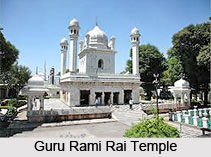 History of Dehradun first finds its proud mention in the primordial Indian Puranas. In this place one can find the true essence of ancient, medieval and modern history of North India.
History of Dehradun first finds its proud mention in the primordial Indian Puranas. In this place one can find the true essence of ancient, medieval and modern history of North India.
Early History of Dehradun
In Skanda Purana, Dun is mentioned as a part of the region called `Kedar Khand`, the abode of Shiva. Another belief states that Dronacharya, the great teacher of Kauravas and Pandavas dwelled here, for a brief period; hence the name, "Drona-nagri". Dehradun during its historical era was part of the region of Kendarkhand, which was the abode of Lord Shiva who gave his name to the Shivalik Hills. Numerous lords and famous personalities have paid a visit to Dehradun, Uttarakhand for peace and atonement. Rama and Lakshmana gave themselves atonement for killing the Lanka King, Ravana. Dronacharya also had landed in Dehradun in quest of peace; the place was then named as Drona Ashram, the habitat of Drona. The five Pandavas also came on their way in Dehradun to the Himalayas to sacrifice themselves.
Medieval History of Dehradun
The recorded history of Dehradun can be traced later in the times subsequent to Christ. In 1469, reformer Guru Nanak, founder of the Sikh faith, sought shelter in the city of Dehradun. It was he who declared the names as Dehra-Camp, Doon-Valley etc. In 1757, Nazib-ud-Daula, Governor of Saharanpur, captured Dehradun; but after his death, the city lay prone to the attack of umpteen invaders. The last invaders were the Gurkhas from Nepal, who annexed it. With the decline of the colonial power in Delhi, the British defeated the forces of Siraj-ud-Daula, Mughal Viceroy, at the Battle of Plassey, with the help of rebellion led by unfaithful Mir Jafar. In 1764, Robert Clive, leading the British forces, defeated the reformed colonial army at Buxar. Under the leadership of Nadir Shah there were repeated invasions from the Afghans and Persians, which had left the Mughal Empire in complete darkness. This can be considered as a build-up of ancient history, leading to the final modern history of Dehradun. In 1761 the defeat of the battle of Panipat had left India in a position that of a high tide, angry and violent, but still divided and lacking in direction. In 1765, the British acquired from the Mughal Emperor, Shah Alam the Diwani Right (revenue collection rights) of the three provinces of Bengal, Bihar and Orissa. The British East India Company was able to infiltrate into the core slowly, but progressively. The Company had brought into security the weak viceroyalties of the Mughals, endangered by the Marathas.
Modern History of Dehradun
The principal objective of the Company had been trade and commerce. Jeopardised with bankruptcy, East India Company appointed Warren Hastings as Governor in 1774. One of his first acts was to clear the dominions of the Nawab of Oudh of the Rohilla menace. Oudh was crucial as a defence state from the Marathas. The Rohilla ruler, Rehmat Khan was defeated in the battle of Miranpur Katra. As a result of treaty with the ruler of Oudh in 1801, the whole of Uttar Pradesh was in the hands of the British. After the defeat of the Marathas by Wellesley and General Lake in 1803, the rest of U.P. also came under their province. The final stage started with a war with the Gurkhas in Nepal from which both came forth with joint respect. The frontier war gained with the Treaty of Sugauli, in 1816 the districts of Garhwal, Nainital, Kumaon and Dehra Dun. Precisely from this starts the modern history of Dehradun. Till 1835, the whole area was included in the Bengal Presidency when it was divided and called the North West Frontier Province, under a Lt. Governor. Due to Dehradun`s charming natural loveliness, it is a favourite residential city and an important educational centre in Uttar Pradesh.



















